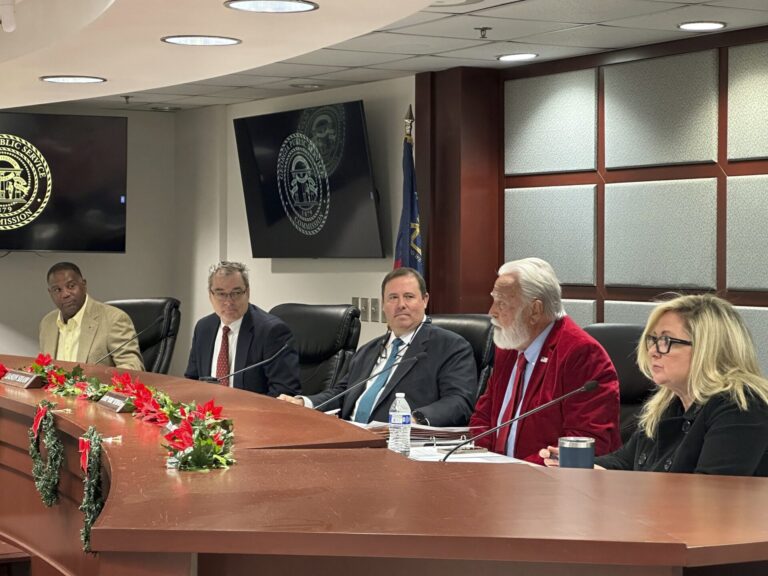Pollution Payday: Analysis of executive compensation and incentives of the largest U.S. investor-owned utilities
Southern Company
Southern Company is a utility company that serves electric and gas customers across Alabama, Georgia, Mississippi, Tennessee, Virginia, and Illinois. Southern Company also operates an unregulated development arm, Southern Power, as well as all of the outstanding common stock or membership interests of Southern Company Services, Southern Linc, Southern Holdings, Southern Nuclear, PowerSecure, and other direct and indirect subsidiaries. Southern Company’s executive compensation consists of three elements: base salary, annual incentive awards, and long-term incentive awards. Base pay makes up approximately 11% of executive compensation, annual incentives awards make up 15%, and long-term incentive awards make up 74%.
Southern Company CEO Thomas A. Fanning’s pay skyrocketed 77.5%, or $12,162,957, from 2017 to 2019. In 2019, Fanning was the highest-paid utility CEO in America at a chart-topping $27,865,185 in total compensation.
The Board of Directors’ Compensation Committee has the responsibility to determine and approve the CEO’s compensation, and it reviews and approves recommendations from the CEO for compensation of the named executive officers (NEOs).
The Compensation Committee retained Pay Governance as its independent executive compensation consultant.
Southern Company uses two separate company peer groups to determine compensation. One group of peers is used to determine direct compensation and another group is used to compare total shareholder return (TSR). TSR is a portion of Southern’s long-term incentive award.
Fanning and CFO Andrew Evans’ annual incentive awards are based on adjusted earnings per share (EPS), weighted at 45%; operational performance targets such as generation availability, customer service, and Plant Vogtle construction execution, weighted at a total of 30%; and an individual evaluation conducted by the Compensation Committee, weighted at 25%.
Other NEOs’ annual incentive awards consist of adjusted earnings per share, weighted at 25%; adjusted net income, weighted at 25%; operational performance targets, weighted at 25%; and an individual evaluation, weighted at 25%.
The adjusted EPS target for the annual incentive plan was set at $3.04 for 2019.
Southern’s long-term incentive rewards executives with ownership of stock primarily based on relative TSR and consolidated return on equity (ROE) over a three-year performance period and a one-year cash from operations target. The 2017 to 2019 consolidated ROE target was 10.5%, and the relative TSR target was the 50th percentile as compared to its utility peer group. The cash from operations target for 2019 was $2.43 billion.
ROE measures how much a utility is allowed to earn in profits on capital expenditures.
The higher the ROE, which is regulated by state utility commissions in Southern’s service territories, the more profit a company earns directly from ratepayers. Alabama Power is allowed one of the highest ROEs in the country at approximately 13.5%, despite Alabama being one of the poorest states in the country. Georgia Power is allowed to over-earn above its regulated ROE and retain some of these over-earnings as profit for the company. Executive incentives based on ROE, coupled with Southern’s ability to retain over-earnings as profit, could encourage executives to push the company to lobby regulators for higher ROEs and for greater capital expenditures against customers’ interests. They could also encourage executives to earn in excess of Southern’s regulated ROE for personal gain.
In determining the EPS and ROE for compensation purposes, the Compensation Committee excluded most, if not all, of the items that might threaten the payout of an executive. For instance, the Compensation Committee excluded the impacts of the failed Kemper County coal gasification project in Mississippi and many of the impacts of the over-budget and behind-schedule construction project at Plant Vogtle.
Southern’s CEO also receives 10% of his long-term incentive based on progress toward the company’s greenhouse gas (GHG) goal. However, Southern’s greenhouse gas target is a misnomer. It does not incent lower greenhouse gas emissions, but rather the addition of zero-emission capacity and the removal of coal; adding 3,080 MW of zero-emissions capacity and/or reduction of coal would qualify Fanning for 100% of his GHG bonus. The goal allows the CEO to receive a bonus even if Southern’s total greenhouse gas emissions increases or if the company adds new fossil fuels to its generation mix. Southern is doing the latter currently, as its Alabama Power subsidiary is currently seeking to add 2,000 MW of gas capacity. (Gas is a fossil fuel that contributes to climate change when leaked and burned.) Southern does not compensate its other NEOs for the addition of zero-emissions capacity, the removal of coal, or any other greenhouse gas reduction target.
Some consumer advocates have questioned Southern’s recovery of executive compensation costs from ratepayers. For instance, Chattanooga Gas Company, a subsidiary of Southern Company, sought approval for both short-term and long-term incentives for its executives and other high-ranking employees. The Tennessee Consumer Advocate opposed the company’s proposal. The Tennessee Public Utility Commission ultimately allowed Chattanooga Gas to recover 50% of the short-term incentive in rates while rejecting the company’s request for recovery of long-term incentives.
While Southern Company has maintained promised levels of executive compensation throughout the COVID-19 pandemic, it has also begun disconnecting customers who have been unable to pay their bills during the crisis. If CEO Fanning took just a 32% compensation cut from his 2019 amount – still leaving him with a compensation of $19 million – Southern could use the savings to immediately wipe out the debt of every single one of the 74,006 Georgia Power customer that was over 90 days in arrears on their bills as of the end of July 2020, according to data the company submitted to Georgia regulators. Instead, Georgia Power disconnected 13,000 customers in July, starting when regulators allowed a state moratorium on disconnections to expire on July 14, 2020.
| CEO compensation ranking among utilities studied, 2019 | 1/19 |
| Compensation ratio: CEO to median employee, 2019 | 166:1 |
| Percent change in CEO compensation, 2017-2019 | +77.5% ($12,162,957) |
| Maximum payout of performance-based shares as a percentage of target, 2019 | 200% |
| Is Southern’s executive compensation structure aligned with decarbonization? | No. CEO Tom Fanning receives a bonus for the addition of zero-carbon emitting resources and the reduction of coal. However, Fanning is allowed to earn his bonus even with the addition of new fossil gas infrastructure to the Southern system. Other NEOs, including for Southern’s operating companies, do not receive a bonus for any decarbonization activities. |
| Is there evidence from SEC filings that Southern is using misleading financial metrics to determine executive compensation? | Yes. As part of its determinations of EPS and ROE for performance goals from 2017 to 2019, Southern Company excluded legal expenses and tax impacts related to plants under construction. While the company did not name these plants, the exclusions likely refer to its Plant Vogtle nuclear facility in Georgia. Southern Company added that this exclusion included “additional equity return related to the Kemper IGCC [integrated gasification combined cycle] in 2017.” Southern was forced by Mississippi regulators to write off $6.4 billion due to losses of the failed Kemper project. Southern Company is inconsistent with its selection of peer utilities depending on the compensation metric. Southern uses larger diversified corporations to help determine direct compensation, which could put upward pressure on its executive pay. However, it excludes those corporations and instead uses many smaller corporations to determine its total shareholder return benchmark, a key metric in determining executive bonuses. |
| What key perquisites or benefits do Southern executives receive? | Tom Fanning received a $127,372 value in approved personal use of corporate aircraft in 2019. NEOs can receive personal use of company-provided tickets for sporting and other entertainment events, spousal expenses related to business travel, non-qualified supplemental retirement benefits, and gifts distributed to and activities provided to attendees at company-sponsored events. |



